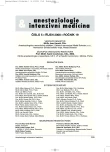-
Medical journals
- Career
General anaesthesia with an awake period for brain surgery
Authors: Duba Jaroslav 1; Gál Roman 1; Svoboda Tomáš 2
Authors‘ workplace: Klinika anesteziologie, resuscitace a intenzivní medicíny FN Brno-Bohunice 1; Neurochirurgická klinika FN Brno-Bohunice 2
Published in: Anest. intenziv. Med., 19, 2008, č. 5, s. 248-251
Category: Anaesthesiology - Original Paper
Overview
Objective:
We performed the study to introduce an anaesthetic technique allowing an awake period with intra-operative electrical stimulation of the cortex during craniotomy for resection of tumours affecting the intrinsic cerebral cortex and to confirm the possibility of an awake period during general anesthesia with spontaneous breathing without invasive airway protection in procedures lasting several hours.Design:
A clinical, prospective study.Setting:
Department of Anaesthesiology, Resuscitation and Intensive Medicine and Department of Neurosurgery at a University Hospital.Materials and methods:
The study included 5 patients with a brain tumour affecting the functional cerebral cortex. TIVA (propofol and remifentanil) without invasive airway management was the anaesthetic technique used.Results:
The average surgical time was 420 min, the average peri-operative emergence period was 73 min. The rates of the anesthetic infusions ranged between 5–8 mg/kg/h of propofol and 1–5 mcg/kg/h of remifentanil. The following complications were observed: 1x considerable discomfort and agitation, 1x epileptic activity and 1x oedema (or expansive behaviour of the lesion).Conclusion:
General anaesthesia with an awake period allows the use of electrical stimulation of the cortex which – following fMRI and neuronavigation – represents the “golden standard“ of resection of brain tumours affecting functional cortical centers.Key words:
brain tumour – functional cortex – intravenous anesthesia – awake period – cortical stimulation
Sources
1. Stejskal, L. et al. Intraoperační stimulační monitorace v neurochirurgii. 1.vyd. Praha: Grada Publishing 2006, 104 s., ISBN 80-247-0964-3.
2. Taylor, M., Bernstein, M. Awake craniotomy with brain mapping as the routine surgical approach to treating patients with supratentorial intraaxial tumours: a prospective trial of 200 cases. J. Neurosurg, 1999, 90, s. 35–41.
3. Huncke, K., van de Wiele, B., Rubinstein, E. H. The asleep-awake-asleep anesthetic technique for intraoperative language mapping. Neurosurgery, 1998, 42, s. 1312–1317.
4. Conte, V., Baratta, P., Songa, V., Fava, E., Bello, L., Stocchetti, N. Propofol-remifentanil anesthesia for tumor surgery with cortical and subcortical mapping: a retrospective study on 37 patients. Riviera Medica, 2006, 12, s. 11–14.
5. Rajciová, J., Schroederová, I., Bartošík, T., Hřib, R., Kraus, R. Anestezie umožňující peroperační kontakt s pacientem v neurochirurgii. Anest. neodkl. Péče, 2001, 12, s. 171–172.
6. Frost, E, Booij, L. Anesthesia in the patient for awake craniotomy. Cur. Opin. Anaesth., 2007, 20, s. 331–335.
Labels
Anaesthesiology, Resuscitation and Inten Intensive Care Medicine
Article was published inAnaesthesiology and Intensive Care Medicine

2008 Issue 5-
All articles in this issue
- The Žalud Days: Dr Pavel Žalud
- General anaesthesia with an awake period for brain surgery
- Difficulties in implementation of the recommendations for the diagnosis and treatment of severe sepsis and septic shock
- Twenty five years of selective digestion decontamination – the questions remain unanswered
- Immunopathogenenis of sepsis
- Anaesthesiology and Intensive Care Medicine
- Journal archive
- Current issue
- Online only
- About the journal
Most read in this issue- General anaesthesia with an awake period for brain surgery
- Difficulties in implementation of the recommendations for the diagnosis and treatment of severe sepsis and septic shock
- Immunopathogenenis of sepsis
- Twenty five years of selective digestion decontamination – the questions remain unanswered
Login#ADS_BOTTOM_SCRIPTS#Forgotten passwordEnter the email address that you registered with. We will send you instructions on how to set a new password.
- Career

